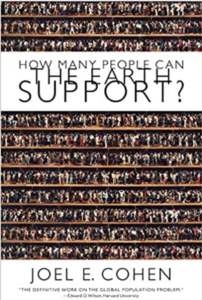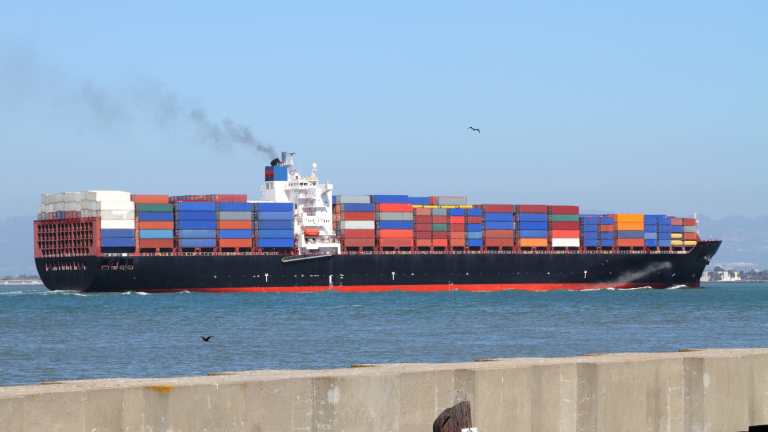What Is the Carrying Capacity of Earth?
Published: May 14, 2021
Alex Casey, Communications Fellow, reports on a conversation she had with Joel E. Cohen, author of How Many People Can the Earth Support?
What Does Carrying Capacity Mean?

Did you know that the term we use to try to determine the number of people the planet can support is the same one used by sailors in the 1840s to weigh the amount of cargo a ship could safely carry?
Carrying capacity became mainstream in the 1870s as a “poetic metaphor” in wildlife management, according to Joel E. Cohen, the professor and mathematician who tried to calculate a definitive number in his 1995 book How Many People Can the Earth Support? The term was further popularized in the 19th century as a way to measure human population growth. In the mid-twentieth century, so-called neo-Malthusians employed the term carrying capacity to identify the number of humans the Earth could support, according to Nathan Sayre, a geographer at UC Berkeley who published a paper on the limitations of carrying capacity as a concept in 2008.

How Many People Can the Earth Support? by Joel E. Cohen
Measuring a dynamic human carrying capacity involves more complications than a static ship, but it implies that there’s a definite upper limit to the planet’s population. An overarching question remains: With a resource-demanding 7.9 billion people today, how many more people can the world hold?
How to Calculate Carrying Capacity
Measuring carrying capacity is often attempted by calculating Earth’s available resources. Edward O. Wilson, the late Harvard sociobiologist, estimated that Earth’s remaining arable land could support about ten billion vegetarians. In Prof. Wilson’s logic, Earth’s remaining 3.5 billion acres of land could produce two billion tons of grains annually.
In 2004, a group of Dutch authors recorded other estimates from a group of 94 scientists. The estimates ranged from 500 million to 1 sextillion (that’s 21 zeroes). Cohen told me that this range was particularly helpful because it proves that estimates depend on methodological differences and assumptions people make about the world they live in.
Average material consumption plays an important role in determining how many people the earth can support, according to Cohen. But so does resource inequality, future technologies, conflict resolution, economic systems, social demographics, physical environment preferences, risk assessments, population variability, sustainability time horizons and values, tastes, and fashions.
“It’s a dubious value in many of its applications. The existence of a carrying capacity in wildlife management is not supported. Animals change their environment and that changes their capacity,” Cohen said. “Humans change their worlds and that changes their capacities.”
There is no metric for what determines human carrying capacity that can be generalized on a community scale, let alone a world one. City-dwelling vegetarians who compost everything may jet around the country multiple times a week for business trips. Rural couples in Niger may struggle to meet the daily fresh water and food needs of their large families. Eco-conscious suburbanites may drive electric vehicles and have solar panels, but eat meat every night for dinner.
All of these ever-changing factors make it difficult to calculate the maximum population the earth can sustain. Moreover, how we consume, emit, treat the planet, practice sustainability, travel, vote in elections—in addition to all other socioeconomic, political, or cultural factors and practices—make it difficult to determine when an area has reached its true carrying capacity.
Did the mass exodus in the wake of Hurricane Katrina represent a breach of New Orleans’ carrying capacity, or was it a failure of the government to anticipate predictable problems when it allowed people to build in low-lying, flood-prone regions? Cohen says it was the latter.
This question becomes a bit more complicated as lower-income countries begin to experience prolonged drought due to declining water tables and variable weather patterns. An estimated 3.7 million people have been displaced as a direct result of climate change and violent conflict in the Sahel, a region that also experiences very high fertility. In Niger, the country with the highest total fertility rate in the world, the average woman will have about 7 children during her lifetime.
Do We Really Need to Estimate Earth’s Human Carrying Capacity?
Since the publication of Cohen’s groundbreaking work, some scientists have claimed that we’re already past the point of no return. The UN Secretary General said 2021 is the ‘make-or-break’ year for climate action. People are consuming Earth’s resources at 1.6 times the sustainable rate. Meanwhile, the world population continues to rise by 80 million a year.
There are two fundamental shifts that must occur to both heighten standards of living and lower climate-related disasters, according to Cohen. The first is food. Right now, 22 percent of the world’s children under five suffer from poor nutrition. Cohen says we must grow enough food to adequately feed the next generation’s future problem solvers.
Voluntary contraception and education are next. An estimated 218 million women in low- and middle-income countries have an unmet need for contraception. According to Cohen, 100 percent of pregnancies should be intended and all women should be able to access the education, services, and supplies needed to control their fertility. When women attain bodily autonomy, they make better choices about factors that affect climate change mitigation (e.g. family size) and adaptation (e.g. where to live).
Contraception in and of itself is a form of climate preparedness; it enables women and families to make better decisions to live better lives. Family planning programs and contraceptive services have had enormous success in promoting health, development, and gender equality since they were introduced in the 1960s. They’ve also had a tremendous effect on the trajectory of human population growth. The global fertility rate has declined from 4.9 children per woman in 1965-1970 to 2.4 today, and the rate of population growth has declined from its peak of 2.05% a year to 0.98%.
With dedicated investments in international family planning and primary and secondary education, especially for girls, we could further slow population growth through smaller families, which would improve health and development outcomes while shrinking humanity’s ecological footprint.
“Do we really need to estimate Earth’s human carrying capacity?” Cohen asked. “Wouldn’t it make sense to use the available knowledge and resources we have to try to fix problems our species and other species face today?”
Perhaps this should be the question we ask, rather than going in circles trying to calculate our lifestyle-dependent upper limit.
An earlier post about carrying capacity, published in April 2017, has been replaced with this updated version. Current world population and reference to E. O. Wilson’s passing added March 4, 2022.

